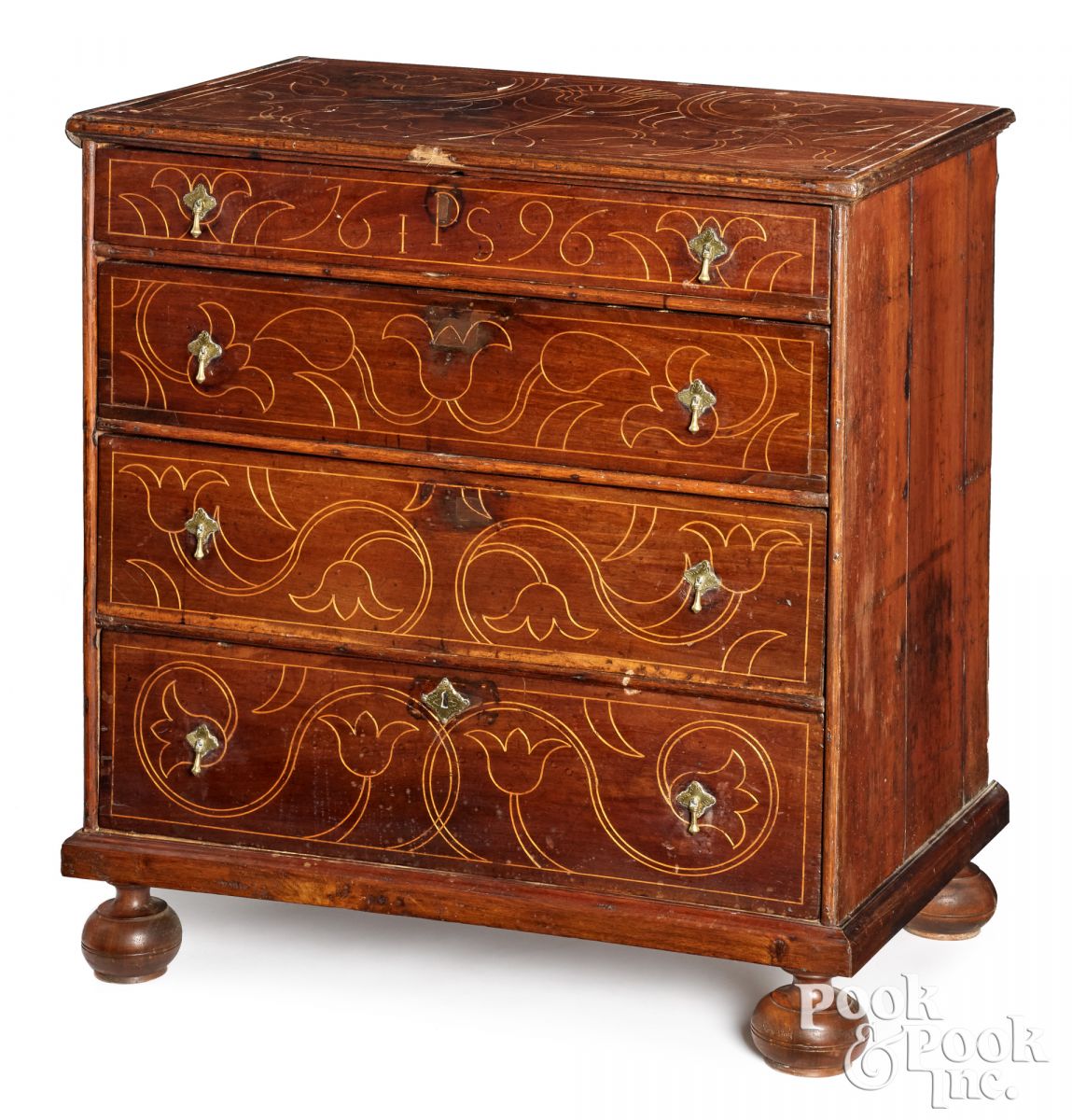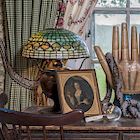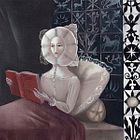The Collection of Margaret Berwind Schiffer
Over the course of three days, January 18th, 19th, and 20th, Pook & Pook will auction three major collections of American and International antiques and art, along with items from other prominent estates, museums, and collectors.
Margaret Berwind Schiffer was a scholar/collector and author, whose many interests included the Delftware, furniture, and needlework of the Quaker, British, and European settlers of Chester County, Pennsylvania. The Schiffer Collection’s eighty-two lots of Delftware chargers, plates, apothecary jars, and bottles features some very fine examples, including lot 215, an English Delftware blue dash Queen Anne charger, ca. 1705, an English King George blue dash charger, ca. 1715, and a rare Delftware rabbit hunting platter, dated 1730 or 1736, is initialed ES. Also of note are three lots of English wine bottles, labeled and dated: Claret 1648, Whit 1643, and Sack 1649.
Furniture includes lot 181, a fine George I mahogany chest of drawers, probably Welsh, dated 1696, initialed IPS, the top and front profusely inlaid with scrolls and tulips. An exceptional miniature Jacobean carved walnut armchair, early 18th c. is illustrated in Schiffer Miniature Antique Furniture, and described as perhaps “the finest surviving Stuart miniature in existence.”

Lot 181, George I mahogany chest of drawers, dated 1696
Amongst the collection of Charles II needleworks are a rare silk embroidered casket, ca. 1670, decorated with various allegorical scenes with figures and animals, retaining its original ebonized pine case, and lot 168, a Charles II stumpwork mirror, ca. 1670, in a mahogany and tortoiseshell veneer frame enclosing a lavishly embroidered border topped by a lute player seated in an orchard arbor, enchanting humans, a lion, a deer, and a mermaid.
The Bud Lear Collection of Copper-Alloy Socket Candlesticks is an exceptional lifetime assemblage of fifty-five lots of copper-alloy candlesticks manufactured between 200 A.D. and 1700. Illustrating the history of development and relationships between forms across Europe, The Lear Collection is composed of notable and one-of-a-kind examples. Lot 748 is an extremely rare brass candlestick in the form of a standing Martin Luther, probably Nuremberg, first half of the 17th c., is the only known example of its kind.
With designs derived from the coeval lion aquamaniles, two lion form candlesticks, 13th/14th c., lots 733 and 734, are attributed to North West Europe, however, one was found in England and bears a distinct resemblance to period English depictions of lions and leopards.
Early English varieties include one of only two known 15th c. English detachable double-socket arm candlesticks, and an exquisite small candlestick, 15th c., having two castellated sockets on Gothic pierced arms. A large English early Tudor Chalice and Paten candlestick is a particularly excellent example of both design and execution in the mid-16th c.
Important English Trumpet candlesticks include a rare late 16th/early 17th c. form, which is one of only two surviving examples known, and a unique and extraordinarily large 17th c. English candlestick, which has a highly unusual removable bobeche, most likely used as a hand-held pan light.
A pair of massive 17th c. sheet brass candlesticks, probably Dutch, with overall repousse decoration, are similar to a pair found in the Victoria & Albert Museum. A brass double socket pricket candlestick, Germany, late 15th c. is an unusual variation of the Three Kings form, with D’Allenagne Collection provenance. Of unusual and totally original form, a brass candlestick, North West Europe, 15th c., has a Heemskerk upper shaft supported by a Three Kings base. A Safavid brass double-armed candlestick, 16th c. is a complex single casting.
Another highlight is a rare Flemish twin-spouted lavabo, 15th c., with cast female heads and animal-form spouts, lot 776.
Notable lots from other collections include lot 785, an important cast brass “Tudor” or “Chalice and Paten” candlestick, mid 16th c., which is very similar to one sold in the William du Pont Collection, Sotheby’s, 2022.
A dramatic oil on slate attributed to Massimo Stanzione (Naples 1585-1656), is titled The Deposition from the Cross, lot 979. A similar painting is in the collection of the National Gallery, London. Provenance includes the Chesrow-Cesario Collection and prior to 1874, the Bartaja Collection of Naples, Italy. A Flemish School, late 16th c., oil on oak panel Madonna and Child, is a lovely scene of the two, each holding a piece of fruit, seated in a landscape.
From Normandy Farms, The Strassburger Estate, comes one of the highlights of the sale, lot 980, Sir John Lavery (British 1856-1941) oil on board titled The Beach Deauville – Morning, signed lower left, titled verso and dated 1926. Also from the same collection are a massive George III mahogany breakfront, and several lots of silver by Paul Storr, including covered entree dishes, toast rack, and armorial plates, 1809-1810.

Please join us in person or online at www.pookandpook.com to preview this exciting sale.
By Pook & Pook Inc
Copyright © 1999 - 2025 Pook & Pook Inc. All Rights Reserved.
- TURNER AUCTIONS + APPRAISALS PRESENTS THE GLADYNE K. MITCHELL COLLECTION ESTATE ON JULY 19
- Celebrate American Heritage with Dana Auctions’ January 25 Antique and Vintage Quilt and Textile Auction
- Exciting Online Auction from Rafael Osona Auctions - Exceptional offerings across multiple categories
- DIAMONDS ARE FOREVER: FINE JEWELRY, DIAMONDS & MORE COME TO TURNER AUCTIONS + APPRAISALS
- TAKE TIME OUT TO VIEW SPORTS MEMORABILIA, COMING TO TURNER AUCTIONS + APPRAISALS ON AUGUST 17
- Rafael Osona Announces Two Day Auction, Aug 3 & 4, 2024 Americana, Fine Arts, Historic Nantucket, Décor ~ Saturday, August 3 The Marine Session ~ Sunday, August 4 Open for Bidding ~ 1000 Lots ~
- Kobe Photomatched Final Game Worn Warm-Up Takes the Stage in SCP’s Summer Premier Auction
- BOHEMIAN CLUB & BOHEMIAN GROVE POSTERS, BOOKS & EPHEMERA COME TO TURNER AUCTIONS + APPRAISALS ON AUGUST 10
- Rafael Osona's Early Summer Auction Gallery Preview July 3,4,5 Auction July 6 - 700 lots
- CARMEL ESTATE AUCTION FEATURES DIVERSE ARTWORKS, DECORATIVE ARTS & MORE AT TURNER AUCTIONS + APPRAISALS
-
Antique Toy Auction at Pook & Pook Inc, with Noel Barrett

-
Sporting Immortality

-
The Collection of Mrs. John Gutfreund – Murray House, Villanova, Pennsylvania

-
Leonora Carrington Oil Painting Sells for More Than Twice the Asking Price in the Latin American Art Auction Hosted by Morton Subastas in Mexico City

-
Peter Tillou Collection Highlights Litchfield Auctions’ 25th Anniversary




 EUR
EUR CAD
CAD AUD
AUD GBP
GBP MXN
MXN HKD
HKD CNY
CNY MYR
MYR SEK
SEK SGD
SGD CHF
CHF THB
THB
